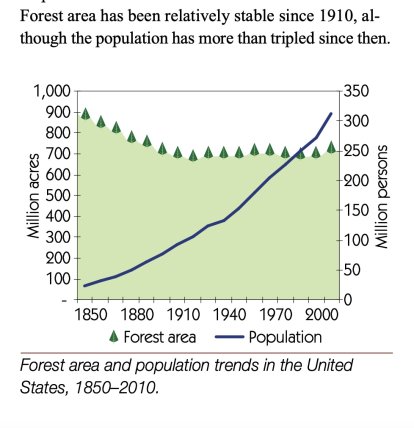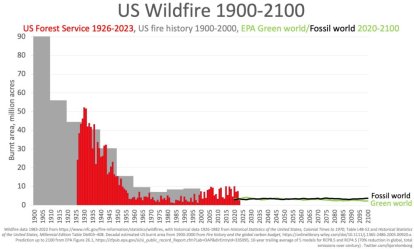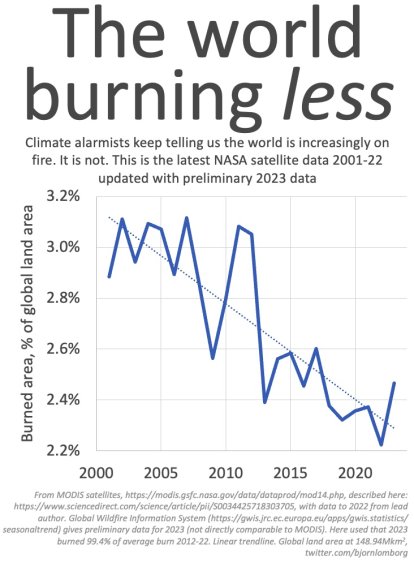Less burned area, stable forests and fewer fires: The data that dismantle climate hysteria
In 2023, the United States recorded the lowest percentage of burned area of this century, and a fraction of the total from the 1930s.

September 28, 2020, Calistoga, CA, USA: Tress and vegetation burn near Pickett Road towards the Kenefick Ranch Vineyard & Winery during the Glass Fire near Calistoga on Monday, Sept. 28, 2020. (Credit Image: © Paul Kitagaki Jr./ZUMA Wire)
Despite sensationalist forecasts regarding climate change, which warn of an increase in fires throughout the world, U.S. burned area last year was the lowest this century, representing less than 7% of what occurred in the 1930s.
According to data from the National Interagency Fire Center, located in Idaho, in 2023, wildfires burned just over 2.5 million hectares across the United States. Although the number seems shocking, it is the lowest figure of this century and a fraction of the impact that there was just under 100 years ago.
Contrary to recurring environmentalist projections, the area in the United States affected by fires has been reduced since the the first quarter of the last century, with only a non-determinant spike during much of the 2000s.

USA Today climate correspondent Doyle Rice wrote in late 2023 that "this year's wildfire season across the mainland U.S. is turning out to be the quietest in 25 years, in terms of acres burned."
If we go a little further back from the record of the National Interagency Fire Center, according to the U.S. Historical Statistics, which is based on annual reports from the first decades of the last century, burned area in 2023 was less than an average of 3% of the area burned in the years between 1900 and 1909.

In a post on X (formerly Twitter), Danish environmentalist, statistician and author Bjorn Lomborg dissects these numbers and, based on several studies, explains that climate change has little to do with increasing or decreasing the impact of fires on land.
Regarding the fires that destroyed part of California in recent years, Lomborg cites a panel of experts who conclude that cause has less to do with climate change and more to do with land management and development.
Scott Stephens, a professor of fire science at the University of California, Berkeley, said during an environmental conference in Washington that 20% to 25% of fires occurred due to climate change, while "75% is the way we manage lands and develop our landscape."
Regarding the significant drop in the impact of forest fires on land since the 1950s, Lomborg comments that "it is likely due to fire suppression."
In USA Today, University of California geography professor Glen MacDonald told journalist Doyle Rice that the low impact of fires in 2023 is mainly due to rain and snow during fire seasons seen in states susceptible such as California, Nevada, Utah and Wyoming.
"The cool and moist conditions in California kept vegetative fuel flammability and fire spread potential low," MacDonald told USA Today.
Likewise, despite what one might assume otherwise, the forest area of the United States has not decreased since 1900. In fact, it has increased slightly since the middle of the last century, according to data from the Department of Agriculture.
"In 1630, the estimated area of U.S. forest land was 1,023 million acres or about 46 percent of the total land area. Since 1630, about 256 million acres of forest land have been converted to other uses—mainly agricultural," reads a report from the Department of Agriculture.
"Forest area has been relatively stable since 1910, although the population has more than tripled since then," the report adds.

Regarding the future, official estimates are not as apocalyptic as environmentalist predictions. According to projections from the Environmental Protection Agency (EPA), even if the world continues the current pace of fossil fuel use, the percentage of surface area burned would remain stable for the next 70 years.
If the scenario is the opposite, and everyone reduces CO2 emissions sharply (by at least 70%), there would hardly be a decrease in the hectares burned for the next 70 years.
In that sense, regarding the impact of forest fires, there would not be a significant difference between living in a completely eco-friendly world or one in which fossil fuels are burned at will, according to EPA projections.

Finally, Bjorn Lomborg also refers to the fact that fires are much less intense today. Regarding this, the author writes: "Contrary to what you constantly hear in the media: Global fire in 2023 burned less than normal."
"Yes, Canada burned very much more (constantly reported), but surely the media should also tell you that the US, Africa, and Europe burned much less?"

Therefore, after a review of the statistics, Lomborg concludes that, although "climate does increase burned area, … zoning and forest management are much more important."

























